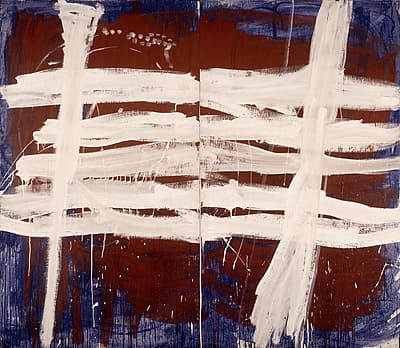
Tony
TUCKSON
Egypt
1921
–
Australia
1973
Australia from 1946;
Europe, United States of America 1967-68
White over red on blue
c.1971
synthetic polymer paint on two composition boards
no inscriptions
213.4 (h)
x 244.0 (w)
cm
Purchased 1978
National Gallery of Australia, Canberra
NGA 1978.1033
© Tony Tuckson. Licensed by Viscopy
- the artist;
- with Geoffrey Legge, Sydney;
- from whom bought by the Australian National Gallery, October 1978
- L'ÚtÚ australien Ó Montpellier
- MusÚe Fabre 27 Sep 1990
- Galerie Saint Ravy d'Art Contemporain 30 Jun 1990 – 27 Sep 1990
- Tony Tuckson: Painting Forever
- Art Gallery of South Australia 28 Mar 2001 – 11 Jun 2001
- Brisbane City Gallery 29 Jun 2001 – 19 Aug 2001
- Art Gallery of Ballarat 14 Sep 2001 – 28 Oct 2001
- Hazelhurst Regional Gallery & Arts Centre 15 Dec 2001 – 10 Feb 2002
- Heide Museum of Modern Art 02 Mar 2002 – 05 May 2002
- Abstract Expressionism: the National Gallery of Australia celebrates the centenaries of Jackson Pollock and Morris Louis
- 14 Jul 2012 – 24 Feb 2013
[this painting brought] us back to something more important: nerves, flesh, blood and bones, the human body and its ways of making contact.
Daniel Thomas1
White over red on blue exudes a passionate energy and vigour, resonating through colour, structure and gesture, yet Tuckson called himself ‘just a Sunday painter’2. He was unencumbered by an extensive palette, using only a translucent lapis-blue ground partly obscured by an opaque layer of ‘ox-blood’ red, and lusciously applied strokes of brilliant white. One can almost see him sweeping paint energetically across the surface of the masonite in dramatic and confident brushstrokes, each layer established in just enough time for the next.
This sense of the artist’s presence parallels Tuckson’s interest in and connection to the mark-making and underlying spirituality of Aboriginal art, especially that of the Melville Island burial poles he saw on his travels to northern Australia. Combined with his formative art studies in London and East Sydney Technical College under artists such as Ralph Balson and Grace Crowley, Tuckson also drew inspiration from Cézanne, Ian Fairweather and Matisse. Without becoming derivative, he distilled their work and developed a unique style.
Friend and colleague, Daniel Thomas wrote:
He [Tuckson] was in fact a very pure and very fine Abstract Expressionist, probably Australia’s best. He was passionately convinced of the humanity communicated by gesture, he spoke of himself as an action painter and I can’t think of any artist’s brushmarks whose scale and pace so clearly reveal generosity, modesty, courage and freshness: every mark is exploratory, not once is there any descent into formula, into the deadness of habit.3
Belinda Cotton 2002
1Daniel Thomas, notes, National Gallery of Australia 1993.
2Sydney Morning Herald 28 August 1975.
3Daniel Thomas, notes, National Gallery of Australia 1993.
Text © National Gallery of Australia, Canberra 2010
From: Anne Gray (ed), Australian art in the National Gallery of Australia, National Gallery of Australia, Canberra, 2002
Discussion of the work
[this painting brought] us back to something more important: nerves, flesh, blood and bones, the human body and its ways of making contact.
Daniel Thomas1
White over red on blue exudes a passionate energy and vigour, resonating through colour, structure and gesture, yet Tuckson called himself ‘just a Sunday painter’2. He was unencumbered by an extensive palette, using only a translucent lapis-blue ground partly obscured by an opaque layer of ‘ox-blood’ red, and lusciously applied strokes of brilliant white. One can almost see him sweeping paint energetically across the surface of the masonite in dramatic and confident brushstrokes, each layer established in just enough time for the next.
This sense of the artist’s presence parallels Tuckson’s interest in and connection to the mark-making and underlying spirituality of Aboriginal art, especially that of the Melville Island burial poles he saw on his travels to northern Australia. Combined with his formative art studies in London and East Sydney Technical College under artists such as Ralph Balson and Grace Crowley, Tuckson also drew inspiration from Cézanne, Ian Fairweather and Matisse. Without becoming derivative, he distilled their work and developed a unique style.
Friend and colleague, Daniel Thomas wrote:
He [Tuckson] was in fact a very pure and very fine Abstract Expressionist, probably Australia’s best. He was passionately convinced of the humanity communicated by gesture, he spoke of himself as an action painter and I can’t think of any artist’s brushmarks whose scale and pace so clearly reveal generosity, modesty, courage and freshness: every mark is exploratory, not once is there any descent into formula, into the deadness of habit.3
Belinda Cotton 2002
1Daniel Thomas, notes, National Gallery of Australia 1993.
2Sydney Morning Herald 28 August 1975.
3Daniel Thomas, notes, National Gallery of Australia 1993.
Text © National Gallery of Australia, Canberra 2010
From: Anne Gray (ed), Australian art in the National Gallery of Australia, National Gallery of Australia, Canberra, 2002
